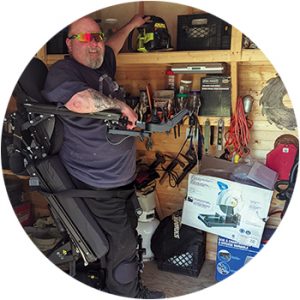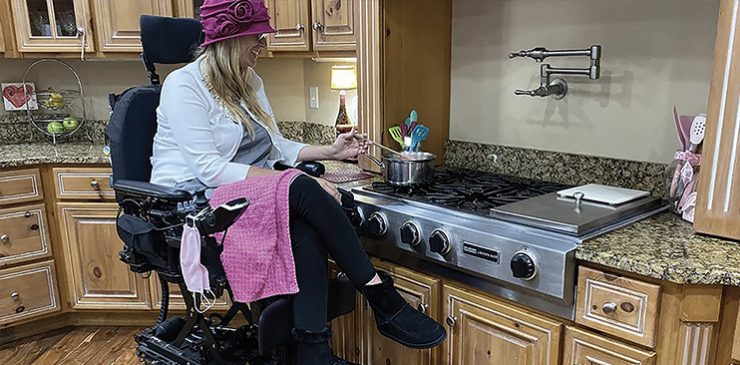Assistive devices play a crucial role in providing people with disabilities a sense of independence, confidence and freedom. Yet not all equipment is designed and funded equally.
With technology rapidly evolving, options for wheelchairs vary in style, size and technical capabilities. There are power-assisted manual wheelchairs, making it easier for users to move around without extra strain on their hands. There are tilt options for power wheelchairs, seat elevation and even standing chairs that give people the ability to access their surroundings from a different angle. The only problem – inadequate funding.
Eric Cloutier, SCIO member and Peer Mentor, understands the challenges of current funding models first-hand. After sustaining a spinal cord injury in 2016, he started using a power wheelchair for mobility. After much contemplation about cost, he purchased his stand-up wheelchair in February 2020 as a means to help him walk again, but he quickly discovered the benefits that came with it.
MORE THAN PHYSICAL BENEFITS
There are everyday barriers that impact wheelchair users, and one of them is height. With many aspects of everyday life being designed for standing height, those using wheelchairs experience challenges completing tasks that are beyond their physical reach. A prime example is grocery shopping – with many items placed on high shelves, most people using wheelchairs require assistance to reach basic items, or may avoid the task altogether and order groceries online. Stand-up functionality in modern wheelchairs changes the game.
Eric recalls the freedom he felt when doing the groceries in his standing wheelchair. “When I am shopping, I don’t need to look for people in vests so they can get things for me off the top shelf because I can do it myself”.
But the benefits are more than just physical.
“One of the best parts about the stand-up chair was the ability to be at eye level with others and feeling like my old self,” he shares.
He describes his standing wheelchair as an extension of himself – the ability to stand has provided him with an enhanced sense of autonomy and confidence. Mental and psychological well being are often overlooked when it comes to decisions around what products are funded, and yet, they make a tremendous difference, as Eric’s story highlights.
He told us with great enthusiasm, that while using his standing wheelchair, he was able to do physical work in his backyard. Standing chairs may expand people’s opportunities at home, in the community and at work by allowing them to do tasks and activities that are more difficult to navigate in a standing wheelchair.
BETTER HEALTH
Quality of life is no doubt affected by the type of mobility devices that people use. Studies suggest that regular use of a stand-up wheelchair can induce a variety of health benefits, from improved breathing function, better blood circulation, improvements in bladder and bowel function, alleviation from pressure sores and reduction in spasticity.
“One of the best parts about the stand-up chair was the ability to be at eye level with others and feeling like my old self.” – Eric Cloutier
ELEVATED SEATING
Elevating seating in the power chair industry is becoming increasingly popular, and for good reason. We spoke with Julie Piriano of Quantum Rehab, who shared the benefits that elevating chairs come with. The iLevel® Power Chair for instance, is designed for more independence in mind, allowing users to transfer to and from the chair more easily. The design came from the feedback of standard power chair users, who described difficult experiences with transfers.
 The iLevel® Power Chair allows the user to raise their seat 12 inches in 16 seconds and can reach speeds up to 4.5 MPH while fully elevated. This means the user is able to move forward at the standard walking speed while elevated, enabling users to live life at eye level. When performing transfers, the user is able to lower and raise the seat as needed to ensure gravity is assisting them with the movement.
The iLevel® Power Chair allows the user to raise their seat 12 inches in 16 seconds and can reach speeds up to 4.5 MPH while fully elevated. This means the user is able to move forward at the standard walking speed while elevated, enabling users to live life at eye level. When performing transfers, the user is able to lower and raise the seat as needed to ensure gravity is assisting them with the movement.
Piriano shared that the elevation functionality in this power chair can reduce government-funded health care costs that add up over the years.
“When you look statistically at back injuries to caregivers, they primarily occur during the transfers of the individual they are caring for. This is a huge health care cost that can be reduced, because we have created a circumstance where the transfer is safer and more efficient for both parties involved” said Piriano. “There is also much less wear and tear on the shoulders of the user as they do not need to reach and lift things over their head as frequently.”
GAPS IN FUNDING
Living with a disability comes with many financial considerations. Those with newly sustained SCIs often have to modify their homes and vehicles, on top of purchasing medical supplies for daily use and hiring personal support workers. Many Ontarians do not have the means to buy devices such as stand-up wheelchairs or seat elevating functionality.
While the Assistive Devices Program (ADP) is intended to help subsidize some of the costs of customized equipment for people with disabilities, specific guidelines exclude the funding of equipment that many would benefit from greatly.
Ben King, SCIO community member, who uses a stand-up wheelchair reflects on his experience navigating ADP. “These devices tend to be viewed as ‘wants’ rather than ‘needs’”, he shares. “They do not understand the additional benefit that helps people like myself who have a total loss of movement below my level of injury. When I am standing up, there is a sense of normalcy but it also supplies me with additional health benefits, accessibility and independence when I go out in public. I can also stand up several times a week for 3-4 hours at a time. By doing this, the strength of my bones has increased and my spasms have reduced.”
SUCCESS FOR SOME, GAPS FOR OTHERS
 While both Ben and Eric were fortunate enough to have a strong sense of community and support that helped them cover the cost of their devices, the majority of Ontarians with disabilities are unable to afford the equipment that is often life-changing for the better.
While both Ben and Eric were fortunate enough to have a strong sense of community and support that helped them cover the cost of their devices, the majority of Ontarians with disabilities are unable to afford the equipment that is often life-changing for the better.
Systemic barriers in place make it very difficult for Ontarians with disabilities to thrive and live life to their full potential. With the help of modern technology and access to the appropriate mobility devices such as customized wheelchairs, the barriers are easier to overcome. This is why SCIO continues to advocate for change within the government in the hope of expanding funding for assistive devices.
A power chair with standing capabilities or elevation can start at $25, 000, but the medical costs from not having access to one can far exceed that number.






